| Description | Participants | Summaries | Products |
|---|
NIMBioS Working Group:
Long Transients and Ecological Forecasting
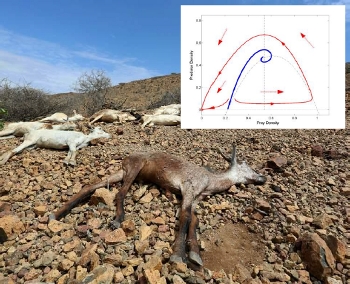
Topic: Long living transients as a bugbear of ecological forecasting: Concepts, models and data
Meeting dates: Mar 1-3, 2017, Oct 26-28, 2017; Sep 26-28, 2018; May 7-9, 2019
Organizers:
Alan Hastings, Environmental Science and Policy, Univ. of California, Davis
Kim Cuddington, Biology, Univ. of Waterloo, Canada
Andrew Morozov, Mathematics, Univ. of Leicester, UK
Sergei Petrovskii, Mathematics, Univ. of Leicester, UK
Objectives:
Predicting sudden changes in ecosystems - "regime shifts" - that often result in population collapse and biodiversity loss is a major issue for ecology and nature conservation. Analysis of population dynamics has traditionally focused on their long-term, asymptotic behavior, while largely disregarding transient dynamics. However, there is a growing understanding that in ecosystems the asymptotic behavior is rarely seen. In particular, a big new challenge for theoretical and empirical ecology is to understand the implications of long-living transients (LLT). The presence of LLT can be an explanation of regimes shifts alternative to "tipping points," so understanding of LLT would substantially improve the quality of long-term forecasting and crisis anticipation. At present, this research area seems to be in its infancy; systematic studies are lacking. Here we seek to make substantial progress in better understanding the role of LLT in ecology and in developing appropriate research techniques for long-term ecosystem management. The overall goal is to construct a unifying theory of LLT by combining the existing empirical facts, mathematical models, computational approaches and appropriate methods of data analysis. First, we will systematize the existing empirical data and models exhibiting LLT and classify the main scenarios of LLT based on the mechanisms that cause them. Second, we will revisit the mathematical techniques of description of LLT in models and set up milestones for necessary future advances. Finally, we will revisit the methods of data analysis in order to increase the reliability of revealing LLT from empirical data.
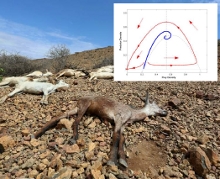
Meeting Summaries
| Mtg # | Dates | Agenda | Summary | Photo | Evaluation |
|---|---|---|---|---|---|
| 1 | Mar 1-3, 2017 | Link | Link | Report | |
| 2 | Oct 26-28, 2017 | Link | Link | - | |
| 3 | Sep 26-28, 2018 | Link | Link | - | |
| 4 | May 7-9, 2019 | TBA | Link | TBA |
Meeting 1 Summary. Existence of long living transients (LLTs) is a phenomenon that can have serious implications for the understanding of ecological dynamics. The meeting brought together ten scientists with complementary expertise with the purpose to work on this problem. The meeting started with short presentations by the group members on various aspects of transient ecological dynamics. Presentations were followed by several intense brainstorming discussion sessions. The group has identified the main challenges in dealing with LLTs and agreed on the list of principal mechanisms resulting in LLTs, such as the existence of different time scales and the existence of ghost attractors. A particular attention was paid to emphasizing the difference between the regime shift scenarios due to graduate change in the environment conditions and the regime shifts due to the effect of LLTs. In particular, it has been discovered that the two alternatives require essentially different management strategies. The group then agreed on the plan of future actions, which includes preparation of a review or viewpoint paper and a more specific research paper with clear task division between the group members and specific deadlines for each stage of the work and the dates and a preliminary agenda for the next meeting.
Meeting 2 summary. This meeting was built on the success of the first meeting of this working group (held in March 2017) where classification of long transients was made by linking them to some properties of dynamical systems. The goals of the second meeting were (i) to further improve the classification of long transients and to resolve remaining mathematical uncertainties, (ii) to discuss the implications of the findings for ecosystems management, and (iii) to prepare a "nearly-final" draft of the first publication. Correspondingly, the morning sessions of the meeting days were focused on the research problems and the afternoon sessions were mostly concerned with more technical issues arising from the preparation of the first paper. The morning discussions of the first day revealed a highly nontrivial relation between long transients and tipping points. In the morning session of the second day, implications of the long-term transient dynamics for ecosystems management and nature conservation were discussed, to reveal that the mismatch between the time scales, if not accounted for, can lead to negative consequences or even complete management failure. In the morning of the third day, the group discussed and agreed on the plan and the timeline of future actions which includes finalizing the review paper (provisionally intended for Science) and the preparation of a draft of a more specific research paper focused on ecosystems management and forecasting in the presence of long transients.
Meeting 3 summary. This meeting was built on the success of the two previous meetings of this working group (March 2017 and October 2017) where classification of long transients was made by linking them to some properties of dynamical systems and to available ecological data. As a result, a Perspectives paper was published in Science [see: Hastings, A., et al. (2018) Transient phenomena in ecology. Science 361, eaat6412] and was favorably covered by media, e.g. see here, here, and here. The goals of the third meeting were (i) to further improve the classification of long transients with a stronger focus on the details of relevant mathematical approaches, with the goal to bring the message to the relevant communities of mathematical ecologists and applied mathematicians, (ii) to work on the second paper aiming to place the conceptual findings of the first two meetings into the context of ecosystem management, and (iii) to work on another paper emphasizing the effects of demographic and environmental stochasticity in a more specific ecological context. Correspondingly, the morning sessions of the meeting mostly consisted of the whole-group discussions of the issues arising, while for the afternoon sessions the participants were sorted out into three task sub-groups to work on the three topics listed above.
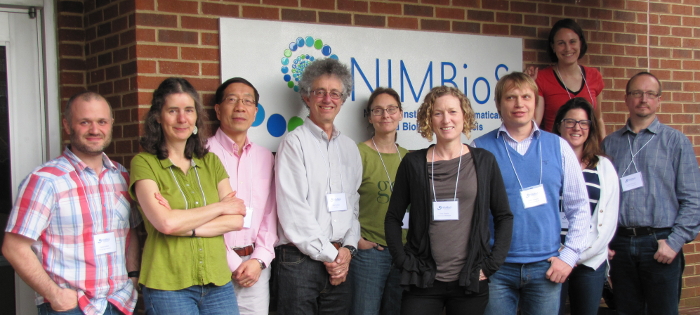 |
| Meeting 1 participants (L to R): Gabriel Gellner, Mary Lou Zeeman, Ying-Cheng Lai, Alan Hastings, Kim Cuddington, Tessa Francis, Andrew Morozov, Katherine Scranton, Karen Abbott, Sergei Petrovskii. |
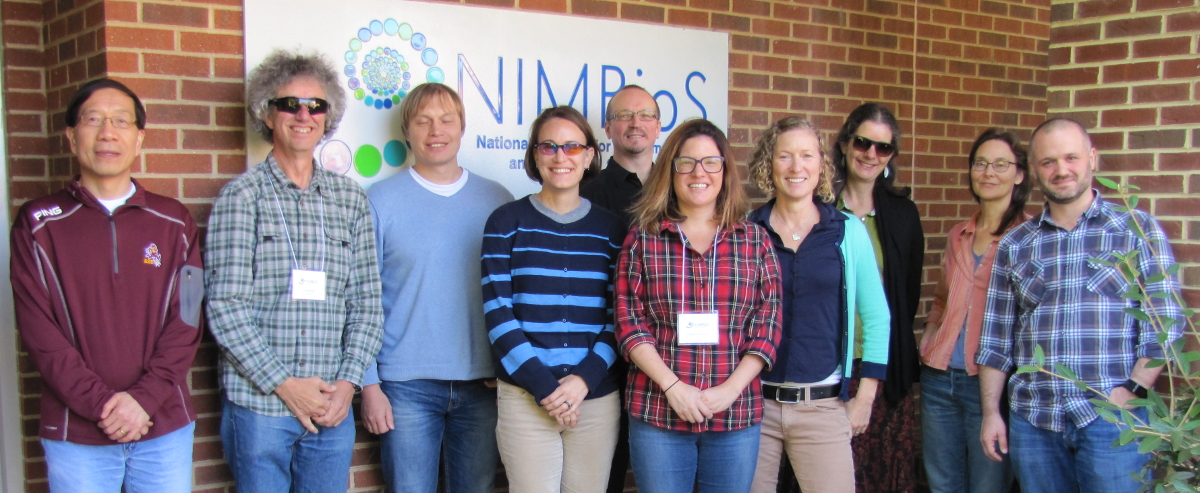 |
| Meeting 2 participants (L to R): Ying-Cheng Lai, Alan Hastings, Andrew Morozov, Karen Abbott, Sergei Petrovskii, Katherine Scranton, Tessa Francis, Mary Lou Zeeman, Kim Cuddington, Gabriel Gellner |
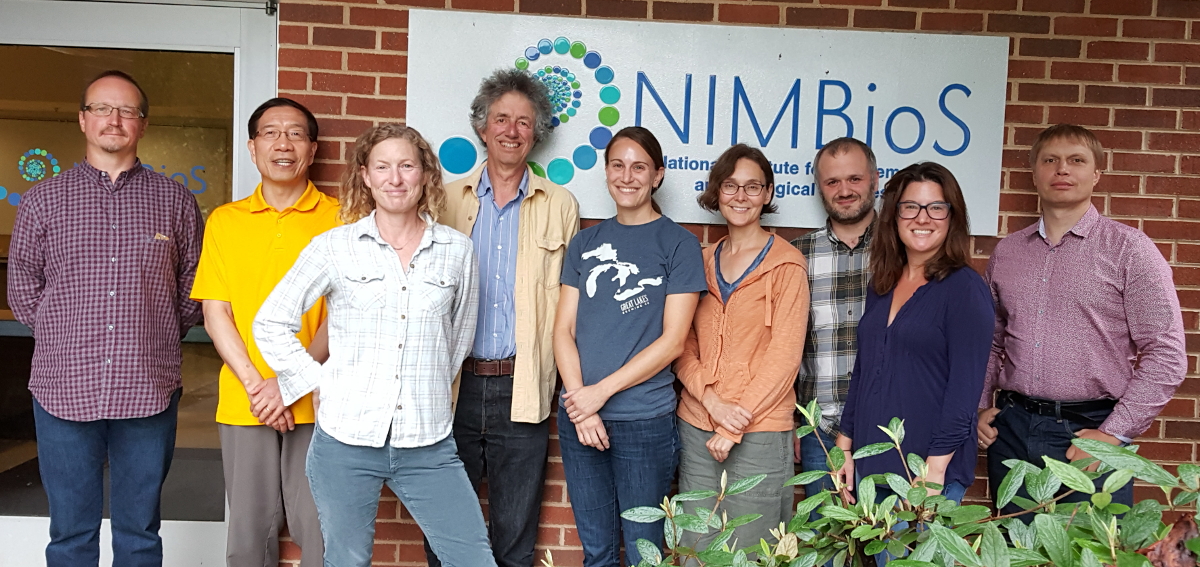 |
| Meeting 3 participants (L to R): Sergei Petrovskii, Ying-Cheng Lai, Tessa Francis, Alan Hastings, Karen Abbott, Kim Cuddington, Gabriel Gellner, Katherine Scranton, Andrew Morozov. |
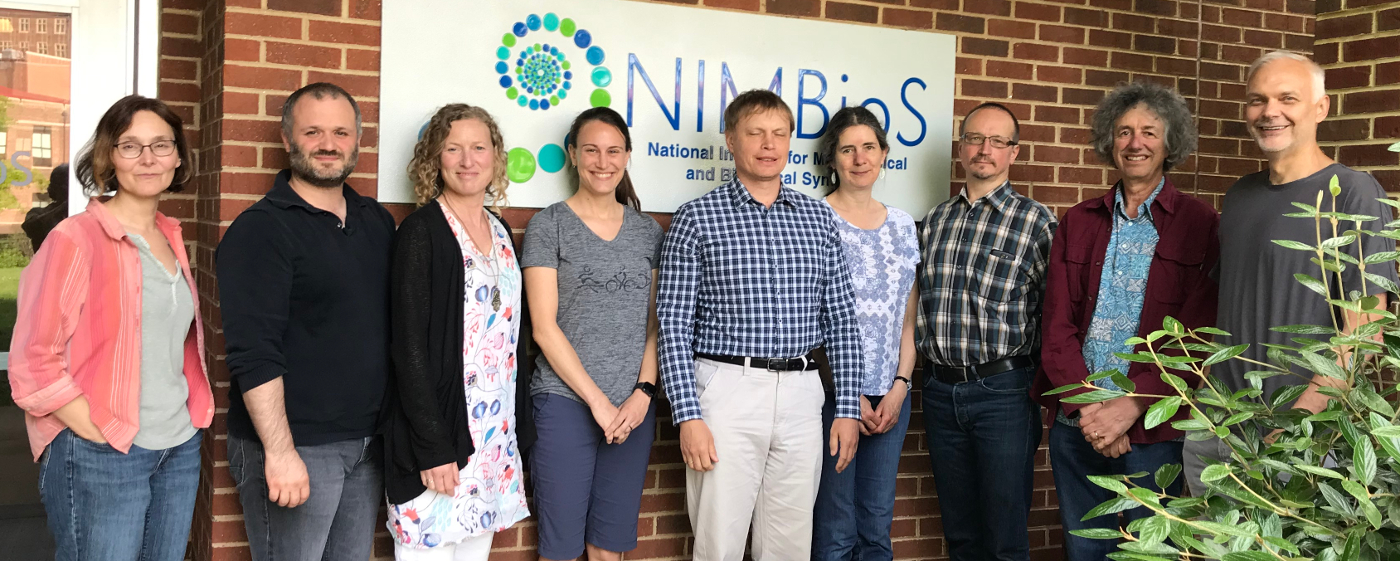 |
| Meeting 4 participants: Kim Cuddington, Gabriel Gellner, Tessa Francis, Karen Abbott, Andrew Morozov, Mary Lou Zeeman, Sergei Petrovskii, Alan Hastings, Sergey Gavrilets. |
NIMBioS Working Groups are chosen to focus on major scientific questions at the interface between biology and mathematics. NIMBioS is particularly interested in questions that integrate diverse fields, require synthesis at multiple scales, and/or make use of or require development of new mathematical/computational approaches. NIMBioS Working Groups are relatively small (up to 10 participants), focus on a well-defined topic, and have well-defined goals and metrics of success. Working Groups will meet up to 3 times over a two-year period, with each meeting lasting up to 2.5 days.
A goal of NIMBioS is to enhance the cadre of researchers capable of interdisciplinary efforts across mathematics and biology. As part of this goal, NIMBioS is committed to promoting diversity in all its activities. Diversity is considered in all its aspects, social and scientific, including gender, ethnicity, scientific field, career stage, geography and type of home institution. Questions regarding diversity issues should be directed to diversity@nimbios.org. You can read more about our Diversity Plan on our NIMBioS Policies web page. The NIMBioS building is fully handicapped accessible.
NIMBioS
1122 Volunteer Blvd., Suite 106
University of Tennessee
Knoxville,
TN 37996-3410
PH: (865) 974-9334
FAX: (865) 974-9461
Contact NIMBioS


